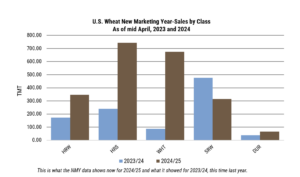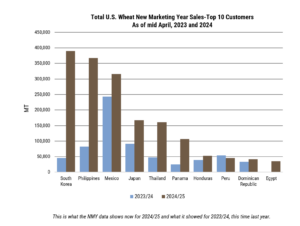With just 6 weeks left in marketing year (MY) 2023/24, many buyers are locking in purchases for June and July shipment, shifting much of the export focus to MY 2024/25, or “new crop,” U.S. wheat sales that are gradually ramping up at a faster pace compared to a year ago. The following will outline MY 2023/24 sales pace to date and provide an initial look at MY 2024/25 export sales.
2023/24 Recap
Throughout MY 2023/24 market conditions turned back to buyers. From June 1, 2023, to present, U.S. wheat FOB export price dropped 15% on average for all classes and export locations. This trend was driven by Black Sea competition pressuring U.S. and global wheat prices. As of April 30, 2024, Russian wheat is still the cheapest on the world market, at $214 per metric ton (MT) FOB (12.5% protein on a dry moisture basis).
As world wheat values fall, U.S. prices follow, and the lower prices have helped boost exports for two U.S. wheat classes. In MY 2023/24 to date, China imported over 1.2 million metric tons (MMT) of soft red winter (SRW), contributing to a 51% increase in total SRW export sales as of April 18, 2024. Likewise, hard red spring (HRS) sales hover 13% ahead of the year prior at 6.4 MMT, making up 34% of the total U.S. wheat export sales. Nonetheless, the positive export performance for HRS and SRW does not offset the significant decline in hard red winter (HRW) and soft white (SW) exports. To date, HRW exports sit at 3.6 MMT, down 28% from the year prior. Likewise, SW exports sit 15% below last year’s pace.
We can expect the 2023/24 sales pace to decline further as customers seek shipments for June and July delivery. For the week ending April 18, for example, net sales of just 82,000 metric tons (MT) were reported for delivery in 2023/24. Despite increased exports for some classes, USDA expects wheat exports to reach 19.3 MMT, the lowest level since 1971/72 if realized. Moreover, the current pace puts total commitments to date 500,000 MT below the projections.

Strong Start
Despite the slower pace of U.S. wheat sales in MY 2023/24, the new crop outlook for 2024/25 is more optimistic. Buyers are beginning to take advantage of lower prices and securing early shipments for MY 2024/25. For the week ending April 18, the total known outstanding sales for MY 2024/25 reached 2.1 MMT, 112% ahead of last year’s pace, with net sales coming in at 371,858 MT.
HRS continues to lead export sales, with 743,580 MT sold to date, a 211% increase from last year. Likewise, soft white sales are up 670% at 675,180 MT, HRW is up 100% to 347,200 MT, and durum sales are up 80% at 66,500 MT. Acting as the outlier, SRW sales are 34% behind last year, at 314,200 MT as prices remain elevated relative to SW.

Contributing to the sales increase, several customers have already bought more U.S. wheat in MY 2024/25 compared to this time last year. So far, South Korea is the top U.S. wheat buyer, with 389,500 MT booked, a significant increase from 45,300 MT the previous year. During the week of March 18, SW prices fell as low as $219/MT (according to the U.S. Wheat Associates Price Report) tracking the decreasing trend in the global wheat market. During this period, South Korean feed grain importers bought feed wheat cargos from the U.S., boosting their SW imports. However, according to Channy Bae, Country Director, USW/Seoul, this is a short-term opportunity for South Korean feed manufacturers and their purchases will shift relative to the price of corn and other origins.
The next largest new crop buyers to date are the Philippines, Mexico, and Japan with year over year increases of 348%, 30% and 83%, respectively. Likewise, buyers in Thailand and Panama have significantly outpaced their 2023/24 purchases, coming in at 239% and 336% higher. Some of the recent increases can be attributed to customers’ need for product and shipment cadence as well as customers taking advantage of more competitive pricing.

Stay Tuned
Stronger early 2024/25 U.S. wheat sales come with one caveat. Traders identify farmer sales as a potential limiting factor moving into MY 2024/25. The lower wheat prices provide less incentive for farmers who use storage as a hedge to sell. The lack of liquidity limits the ability of exporters to aggressively price and market grain to meet the increased demand.
Looking ahead, the May 2024 World Agricultural Supply and Demand Estimates will offer additional insights on U.S. wheat production, exports, and global demand. Likewise, the weekly Commercial Sales Report will provide real time updates to the U.S. wheat sales pace. As always, U.S. Wheat Associates remains committed to offering information and support for buyers transitioning into the 2024/25 marketing year.
By Tyllor Ledford, USW Market Analyst


